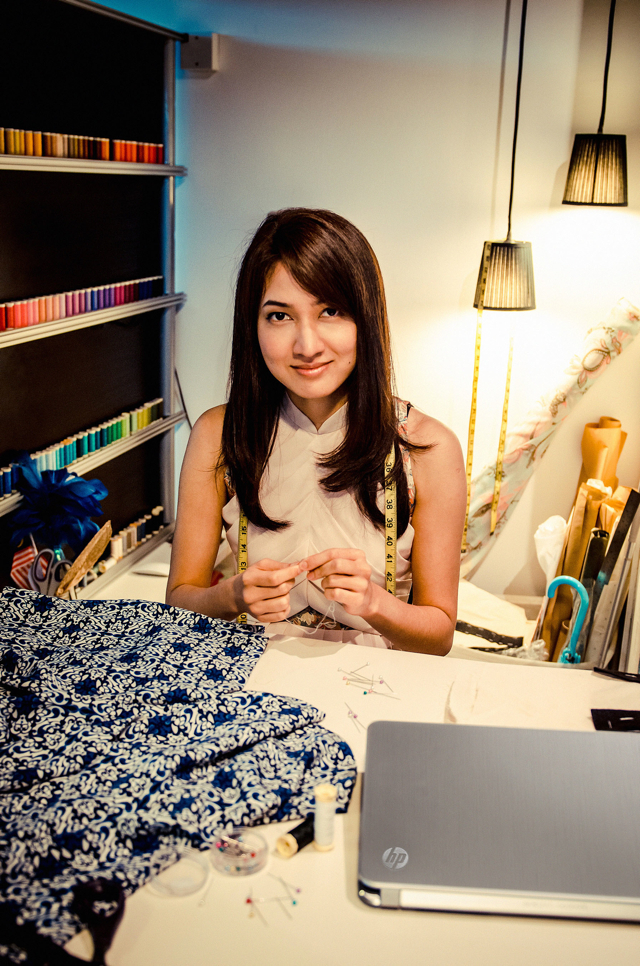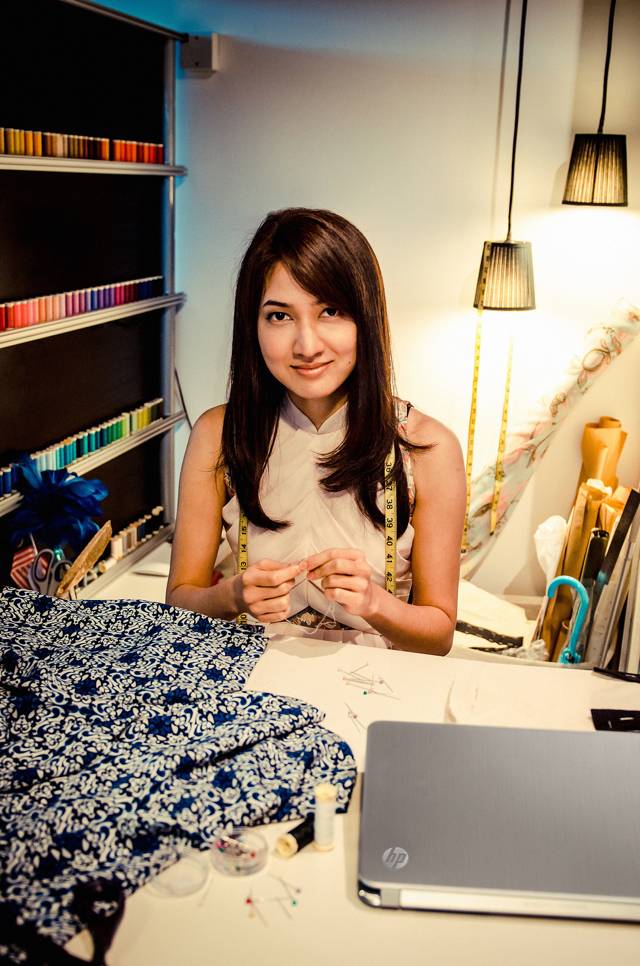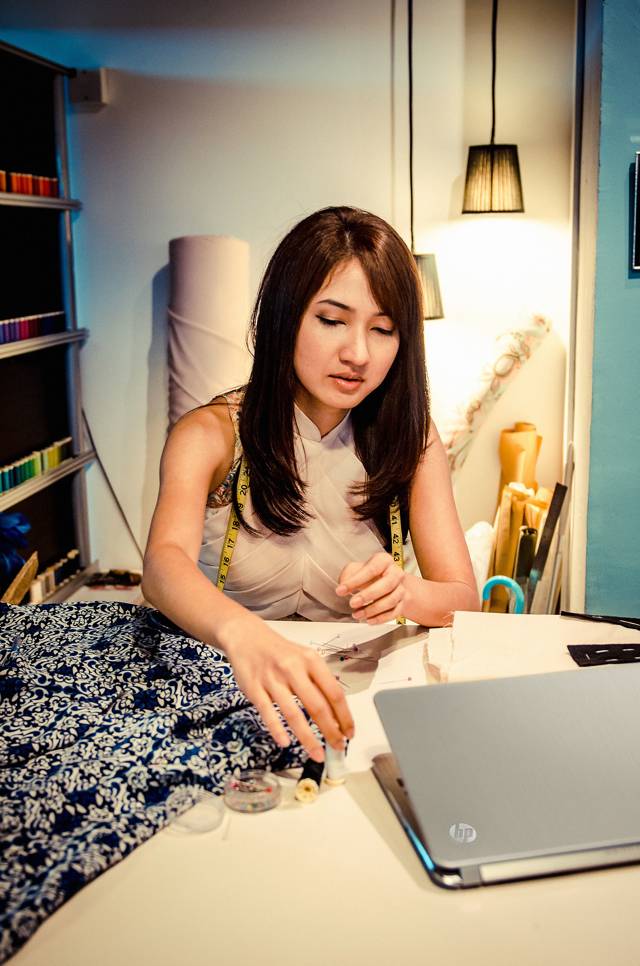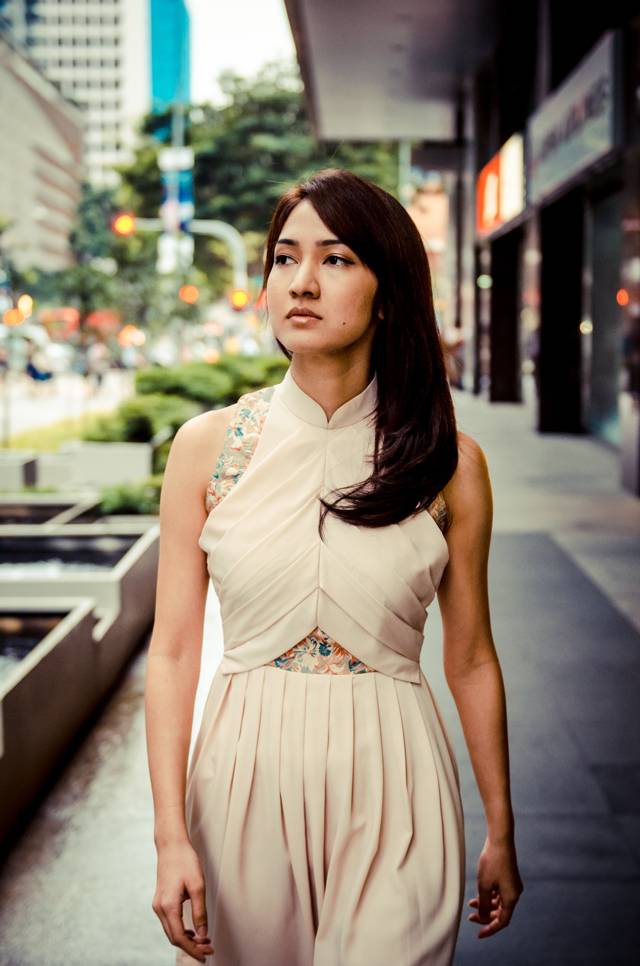
Text by Stanley Lui | Photos by John Tan | Makeup by Sharon Pow
Designer Priscilla Tsu-Jyen Shunmugam born in Kuala Lumpur of both Indian and Chinese parentage, founded the Ong Shunmugam label in 2010, naming it with a combination of both her parents’ surnames.
The womenswear label thus started its humble quest of crafting beautiful clothing that focuses on the bespoke and sartorial construction of fabric. Putting a much-needed contemporary spin on traditional clothing such as the Cheongsam, Samfu, Sari and the Kebaya, Ong Shunmugam places great importance on the cut and the fit of the clothing, striving for longevity through its classic-inspired designs.
After graduating with a law degree at the National University of Singapore, Priscilla spent a year studying dressmaking in Nottingham with a retired couturier and attended pattern-cutting courses at the prestigious London College of Fashion as she pursued her passion in fashion.
On her return to Singapore in late 2009, she launched her first ready-to-wear fashion collection, "Orientalism" and following that, her first ready-to-wear cheongsam collection titled "Guardianship".
Debuting at the Singapore Blueprint trade platform in May 2012, Ong Shunmugam also featured in the "In the Mood for Cheongsam" exhibition at the National Museum of Singapore, the 2012 Grey Goose Guild as well as the prestigious Paris Fashion Week with Future Fashion Now. In 2012, the label won the Breakout Local Label title at Singapore's Cleo Fashion Awards and won the Designer of the Year award at the annual ELLE Singapore Awards.
SENATUS met with Priscilla at her boutique Atelier Ong Shunmugam located at the Hong Leong Building in Singapore to learn more about the journey of her brand so far.
Tell us about the challenges you faced starting your own label
Well, I had very little capital to begin with and I couldn't get any funding from the government agencies. I also did not have the necessary connections as I came from a very different industry (law vs. fashion). So that was scary for me.
I guess the challenges were a lack of capital, connections and experience. Singapore being Singapore, I had to deal with high costs and the shortage of skilled labour as well as resources. I also had to convince a skeptical audience when it came to being a local label. When you put all these together, these are challenges with a capital C.
What matters at the end of the day is the quality of your products and services.


How do you go about creating your designs?
I did not go through formal fashion design training like most of my peers did, so what I had where either through instinct or self-taught. Because of that, there are a lot of things I do differently when it comes to design.
For example, almost every designer I know has a mood board… I have none.
I never look at the magazines when I design as my fear is that I will copy... I don't want to do that.
Maybe because of my approach, the design process for me is actually very fast.
Was it difficult creating collection after collection for Paris Fashion Week followed by Grey Goose Guild in such a short span of time?
For my Spring/Summer 2013 collection, it was designed within 3 hours on a flight from Hong Kong to Singapore. Usually when I am on a flight, it irritates me that I cannot do anything. So I take out my diary and start drawing but at the same time thinking not to waste too much time doing it.
So instead of drawing 200 dresses, I usually only draw 10 dresses which will all end up becoming the actual designs.
The hard part was actually the sourcing of the fabrics and the production itself. That really drove us crazy. We had 6 weeks to do it, followed by Grey Goose Guild. It was a very trying period. In fact, the whole year - from Chinese New Year or January onwards - we did not slow down at all.
So how I do it is, I get 5 hours of sleep everyday and work 7 days a week.
How do you manage your production process? Do you have a team of seamstresses?
I have 2 seamstresses so I no longer sew, but I still do my patterns and they will do up the samples. I spend almost everyday with them. So once I close the shop, I head over to the studio because I need to supervise.

Tell me about your latest collection, what is the inspiration behind it?
My Spring/Summer 2013 collection is inspired by principle characteristics of Asian architecture, in particular Islamic, Indian and Japanese architecture.
It had dawned upon me that space, structure and time is becoming very sensitive in Singapore. There is an expiry date to everything here and you just don’t know how long these building are going to be around. The same applies beyond Singapore.
So for this collection, I am exploring architecture in fashion, along with the question as to what to do with old buildings or old things in the face of modern development.
The old-and-new concept sits well with what we are trying to at Ong Shunmugam… it’s something people can relate to and I leave it open to their own interpretation.
So you make use of the Internet to do your research on architecture?
Yes I do, to find out what are some of the characteristics that run through these buildings.
More importantly, I spend a lot of time on the Internet these days not only as part of my research but to interact with people who are into architecture or have traveled to sites of stunning architecture. They would email me pictures of the places they went to which were handy as a references.
How do you make use of social media platforms to reach out to your customers?
For a young brand that does not have enough capital to engage in a big marketing campaign, social media is very important to us. Facebook attracts users from a wide spectrum of the ages and even though some of our clients may not have a Facebook account, they would still go to our Facebook page which has content made available to the public.
In a way, having a Facebook page help consumers get comfortable with our presence online. Seeing the amount of 'likes' and their reaction – be it commenting or sharing – is also a good way to receive consumer feedback about the brand.
How about your online store? How does it help in reaching out to a larger consumer market?
Online sales certainly cannot be compared with in-store sales, but they are definitely allowing us to sell to people overseas. For example, we’ve sent our clothing to Switzerland, Washington, and even Puerto Rico.
Maintaining an online shop is important. Apart from the fact that you can allow people to enter the website to see pictures and read about the designs, having an online presence is also powerful in the sense that consumers may not buy an item online but they can already get to know more about the brand.

Going forward what are your plans and vision for 2013?
Well first, we need to sell this collection. When I was starting out, I was advised by some sources to just do bridal as “that is where the money is”… 2 years on we’ve managed to prove them wrong.
I want people to understand that running a fashion label is not just about having a catwalk show, it's not so much about appearing in magazines or partying but it's all about the hard figures.
If you want to put out a new collection, your current collection has to sell.
I hope that 2013 would be the year that more and more women, not just in Singapore but in Asia and beyond, will come to learn more about our brand. I think the important part of our branding is that we are not just selling clothes blindly but rather, we have a story to tell.













